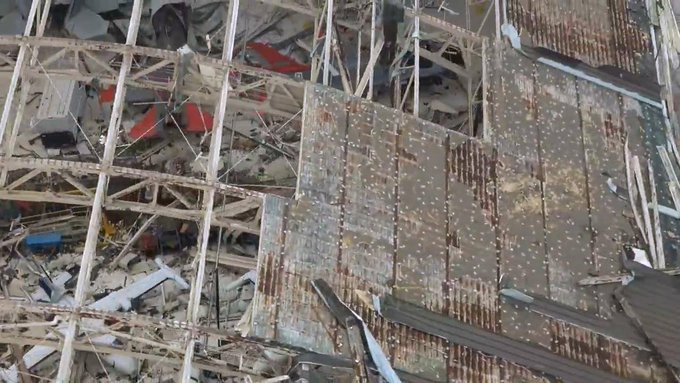Hurricane Cost May Skyrocket As Billions In Stealth Fighter Jets Unaccounted For; Tyndall AFB "Complete Loss"
13
October, 2018
After
Hurricane Michael rendered Tyndall Air Force Base a "complete
loss" from "widespread, catastrophic damage" -
questions remain over nearly two-dozen F-22 Stealth Fighters which
are unaccounted for.
Static
F-15 display flipped over
According
to the New
York Times,
Tyndall is home to 55 stealth fighters, "which
cost a dizzying $339 million each."
Before Michael hit, the Air Force evacuated at least 33 of the planes
to Wright-Patterson Air Force Base in Ohio, however they would not
comment on the status of the remaining 22 fighters.
 F-22
Raptor
F-22
RaptorAir Force officials have not disclosed the whereabouts of the remaining 22 planes, other than to say that a number of aircraft were left at the base because of maintenance or safety reasons.
An Air Force spokeswoman, Maj. Malinda Singleton, would not confirm that any of the aircraft left behind were F-22s.
But photos and video from the wreckage of the base showed the distinctive contours of the F-22’s squared tail fins and angled vertical stabilizers amid a jumble of rubble in the base’s largest building, Hangar 5. Another photo shows the distinctive jet in a smaller hangar that had its doors and a wall ripped off by wind.
All of the hangars at the base were damaged, Major Singleton said Friday. “We anticipate the aircraft parked inside may be damaged as well,” she said, “but we won’t know the extent until our crews can safely enter those hangars and make an assessment.” -NYT
F-22s
are notoriously finicky and, as the Times puts
it "not always flight-worthy." The Air Force reported
earlier this year that just 49% of F-22s were mission ready at any
given time - the
lowest rate of any fighter in the Air Force.
The total value of the unaccounted-for fighters is arouind $7.5
billion.
The
eye of Hurricane Michael traveled directly over Tyndall, peeling back
stormproof roofs like tin cans and flipping over an F-15 fighter jet
display at the base entrance.
When it was over, the base lay in ruins, amid what the Air Force called “widespread catastrophic damage.” There were no reported injuries, in part because nearly all personnel had been ordered to leave in advance of the Category 4 hurricane’s landfall. Commanders still sifting through mounds of wreckage Thursday could not say when evacuation orders would be lifted. -NYT
The
last Air Force Base to suffer catastrophic damage was in 1992, when
Category 5 Hurricane Andrew slammed into Homestead Air Force Base
just south of Miami with winds estimated at 150 m.p.h. Two years
later it was reopened as a smaller, Air Force Reserve base.
Tyndall, where about 3,600 airmen are stationed, sits on 29,000 acres that include undeveloped woods and beaches, as well as stores, restaurants, schools, a bowling alley and quiet, tree-lined streets with hundreds of homes for both active-duty and retired military. Video footage captured the ruin there, too: The high-powered storm skinned roofs, shattered windows, and tossed cars and trailers like toys, transforming the normally pristine base into a trash heap. Multistory barracks buildings stood open to the sky. -NYT
"Tyndall
residents and evacuated personnel should remain at their safe
location," said Col. Brian Laidlaw on Thursday. "We
are actively developing plans to reunite families and plan to provide
safe passage back to base housing.
The
last Air Force Base to suffer catastrophic damage was in 1992, when
Category 5 Hurricane Andrew slammed into Homestead Air Force Base
just south of Miami with winds estimated at 150 m.p.h. Two years
later it was reopened as a smaller, Air Force Reserve base.
Tyndall, where about 3,600 airmen are stationed, sits on 29,000 acres that include undeveloped woods and beaches, as well as stores, restaurants, schools, a bowling alley and quiet, tree-lined streets with hundreds of homes for both active-duty and retired military. Video footage captured the ruin there, too: The high-powered storm skinned roofs, shattered windows, and tossed cars and trailers like toys, transforming the normally pristine base into a trash heap. Multistory barracks buildings stood open to the sky. -NYT
The
last Air Force Base to suffer catastrophic damage was in 1992, when
Category 5 Hurricane Andrew slammed into Homestead Air Force Base
just south of Miami with winds estimated at 150 m.p.h. Two years
later it was reopened as a smaller, Air Force Reserve base.
Tyndall, where about 3,600 airmen are stationed, sits on 29,000 acres that include undeveloped woods and beaches, as well as stores, restaurants, schools, a bowling alley and quiet, tree-lined streets with hundreds of homes for both active-duty and retired military. Video footage captured the ruin there, too: The high-powered storm skinned roofs, shattered windows, and tossed cars and trailers like toys, transforming the normally pristine base into a trash heap. Multistory barracks buildings stood open to the sky. -NYT
"Tyndall
residents and evacuated personnel should remain at their safe
location," said Col. Brian Laidlaw on Thursday. "We
are actively developing plans to reunite families and plan to provide
safe passage back to base housing.









No comments:
Post a Comment
Note: only a member of this blog may post a comment.